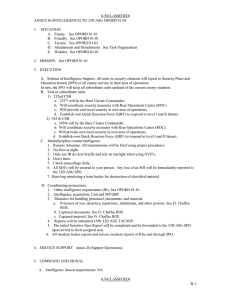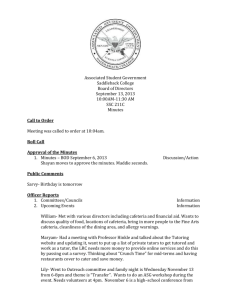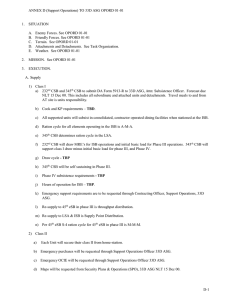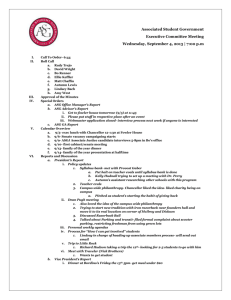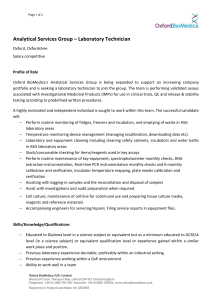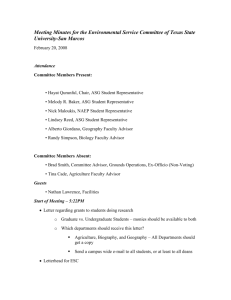ANNEX N (REAR OPERATIONS) TO THE 33D ASG OPERATIONS ORDER...
advertisement
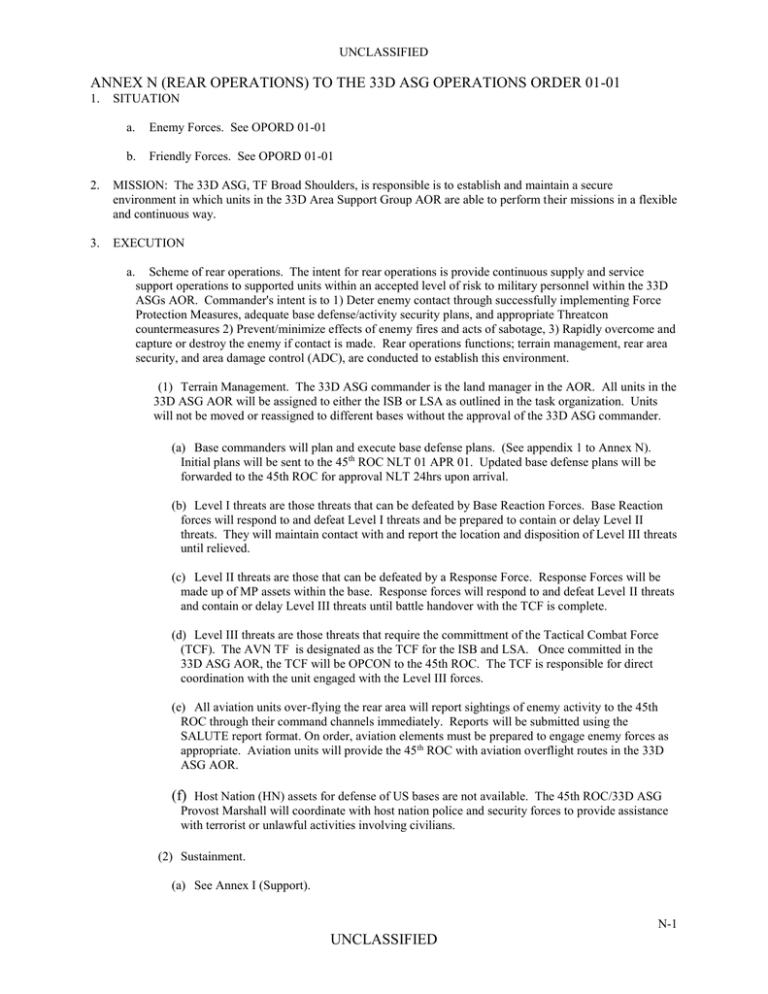
UNCLASSIFIED ANNEX N (REAR OPERATIONS) TO THE 33D ASG OPERATIONS ORDER 01-01 1. SITUATION a. Enemy Forces. See OPORD 01-01 b. Friendly Forces. See OPORD 01-01 2. MISSION: The 33D ASG, TF Broad Shoulders, is responsible is to establish and maintain a secure environment in which units in the 33D Area Support Group AOR are able to perform their missions in a flexible and continuous way. 3. EXECUTION a. Scheme of rear operations. The intent for rear operations is provide continuous supply and service support operations to supported units within an accepted level of risk to military personnel within the 33D ASGs AOR. Commander's intent is to 1) Deter enemy contact through successfully implementing Force Protection Measures, adequate base defense/activity security plans, and appropriate Threatcon countermeasures 2) Prevent/minimize effects of enemy fires and acts of sabotage, 3) Rapidly overcome and capture or destroy the enemy if contact is made. Rear operations functions; terrain management, rear area security, and area damage control (ADC), are conducted to establish this environment. (1) Terrain Management. The 33D ASG commander is the land manager in the AOR. All units in the 33D ASG AOR will be assigned to either the ISB or LSA as outlined in the task organization. Units will not be moved or reassigned to different bases without the approval of the 33D ASG commander. (a) Base commanders will plan and execute base defense plans. (See appendix 1 to Annex N). Initial plans will be sent to the 45th ROC NLT 01 APR 01. Updated base defense plans will be forwarded to the 45th ROC for approval NLT 24hrs upon arrival. (b) Level I threats are those threats that can be defeated by Base Reaction Forces. Base Reaction forces will respond to and defeat Level I threats and be prepared to contain or delay Level II threats. They will maintain contact with and report the location and disposition of Level III threats until relieved. (c) Level II threats are those that can be defeated by a Response Force. Response Forces will be made up of MP assets within the base. Response forces will respond to and defeat Level II threats and contain or delay Level III threats until battle handover with the TCF is complete. (d) Level III threats are those threats that require the committment of the Tactical Combat Force (TCF). The AVN TF is designated as the TCF for the ISB and LSA. Once committed in the 33D ASG AOR, the TCF will be OPCON to the 45th ROC. The TCF is responsible for direct coordination with the unit engaged with the Level III forces. (e) All aviation units over-flying the rear area will report sightings of enemy activity to the 45th ROC through their command channels immediately. Reports will be submitted using the SALUTE report format. On order, aviation elements must be prepared to engage enemy forces as appropriate. Aviation units will provide the 45 th ROC with aviation overflight routes in the 33D ASG AOR. (f) Host Nation (HN) assets for defense of US bases are not available. The 45th ROC/33D ASG Provost Marshall will coordinate with host nation police and security forces to provide assistance with terrorist or unlawful activities involving civilians. (2) Sustainment. (a) See Annex I (Support). N-1 UNCLASSIFIED UNCLASSIFIED ANNEX N (REAR OPERATIONS) TO THE 33D ASG OPERATIONS ORDER 01-01 (b) Critical CSS facilities and assets in the 33D ASG AOR are C2, Barge (SPODs) sites, APODs, railheads, water supply points and Class I, III and V stockage points, power generation, railways, MSRs and key bridges. Base Commanders will report these locations to the 45th ROC. Critical C2 and CSS facilities will receive priority of Rear Area air defense protection. Coordination of ADA assets is the responsibility of the CSB CDRs and Fire Support Section of the 45th ROC. (3) Movements. (a) Units must request permission from the 798th MCT and controlling CSB to enter, depart or move within the 33D ASG AOR. (b) The 933 MP CO will provide Battlefield Circulation Control (BCC) and route security in the 33D ASG AOR. (c) Priority of movement east on MSRs is to maneuver forces and units hauling Class III and Class V supplies. Priority of movement west is to ground MEDEVAC units. (d) Routing of Displaced Civilians/Refugees traveling through the 33D ASG AOR will be IAW Appendix 2, Annex K (Provost Marshall) responsibility of the CSB CDR as coordinated with MP and CA units and 45th ROC/33D ASG. b. Tasks to Subordinate Units. (1) 45th ROC (a) Coordinate Area Damage Control assets to mitigate effects of enemy attacks in the rear area IAW following priorities: 1. Barge (SPOD) sites, APODS 2. Transportation Infrastructure 3. Critical CS and CSS facilities (b) Coordinate engineer support for base to enhance force protection throughout the 33D ASG AOR IAW the following priorities: 1. Class III and V storage facilities 2. APODs 3. C2 4. ADA (c) Establish and submit 33D ASG AOR security plans to the Higher HQ ROC. (d) Provide security plan update to the 33D ASG SPO on a daily basis. (e) Establish terrain management procedures within assigned AOR. (f) Coordinate for and establish the TCF force for the ISB and LSA and procedures for committing such a force against Level III threats. (g) Provide Base Defense Liaison Teams (BDLTs) to the ISB and LSA Base Defense Operations Center (BDOC) to monitor the progress of base and activity defensive posture. N-2 UNCLASSIFIED UNCLASSIFIED ANNEX N (REAR OPERATIONS) TO THE 33D ASG OPERATIONS ORDER 01-01 (2) Base Commanders: Responsible for all tasks contained in Appendix 2 – Base Commander Tasks to include the establishment of a BDOC for their AOR. Establish and maintain communications with the 45th ROC. Provide initial Base Defense Plans and sketches to 45 th ROC NLT 01 APR 01. Provide updated plans to BDLTs NLT 24 hours after initial link up at BDOC. Insure defense includes measures to prevent mortar shelling from the opposite bank of the Arkansas River. In the event of an NBC incident, closest unit commandeers will be tasked with NBC recon. All NBC activities to include establishment of Hasty DECON sites in your AOR. A minimum of 4 sites are required based upon chemical downwind direction. (3) 232nd CSB (a) Perform maintenance and ADC activity within the 232 nd CSB AOR to include MSRs under their control. (b) Perform other ADC missions as directed by the 45th ROC. (c) Perform force protection missions as directed by the 45th ROC. (d) Coordinate requests for MP, ENG, and EOD support through 45th ROC. (e) Provide support for BDLTs. (4) 345 CSB (a) Perform maintenance and ADC activity within 345 CSB AOR to include MSRs under their control. (b) Perform other ADC missions as directed by the 45th ROC. (c) Perform force protection missions as directed by the 45th ROC. (d) Coordinate requests for MP, ENG, and EOD support through 45 th ROC (e) Provide support for BDLTs. (5) 933 MP CO (a) Dedicate 3 PLTs to LSA AO activities (b) Dedicate 1 PLT to ISB AO activities (c) Conduct Battlefield Circulation Control (BCC). (d) Conduct Area Security in Sector. (e) Provide TOC Security. (f) Defeat Level II threats as directed by the 45th ROC. (g) Train and assist CSB personnel in the establishment of EPW holding areas. (h) Establish and operate EPW camps in the 33D ASG AOR as directed by Provost Marshall. (i) Develop and coordinate plan for handling EPWs and displaced civilians within the AOR. (j) Provide security for EPW transport. (k) Provide a copy of initial patrolling plans and overlays to 45 th ROC NLT 01 APR 01. Provide N-3 UNCLASSIFIED UNCLASSIFIED ANNEX N (REAR OPERATIONS) TO THE 33D ASG OPERATIONS ORDER 01-01 updated plans NLT 48 hours after your unit closes on the ISB and/or LSA. (l) Conduct EOD operations in assigned AOR. (6) C CO 120th ENG (a) Provide ADC and base defense ENG support in ISB and LSA (b) Coordinate activities and provide ENG plan through 45 th ROC/33D ASG and supported CSB. (7) Other assets located in the 33D ASG AOR will provide force protection as directed by the 45th ROC as needed. c. Coordinating Instructions. (1) Commander's Critical Information Requirements (CCIR) (see Annex B) (2) Priority for rear operations will be protection of key facilities and LOCs and sustainment of reception and forward movement of material and units. (3) Forward construction, damage repair, and maintenance requests to the 45th ROC for consolidation, review, and approval. 4. SERVICE SUPPORT. See Annex I (Support). 5. COMMAND AND SIGNAL a. Command (See Operations Overlay for Base Locations) (1) The 232nd CSB Commander is the ISB Base commander. (2) The 345 CSB Commander is the LSA Base commander. (3) Succession of command: (a) ASG AOR. 33D ASG (ISB), 33D ASG FWD (LSA), 232d CSB (ISB), 345 CSB (LSA). (b) Base. In the event a change of Base command is necessary, the next senior commander in the Base will assume command. b. Signal: See OPORD 01-01 APPENDICES: 1 - Base Defense Plan Template 2 – Base/Base Cluster Commanders Checklist 3 - OPSEC N-4 UNCLASSIFIED 1. GENERAL. This ANNEX provides guidance for the secure planning, coordination, and conduct of SOONER SUPPORT 2. CONCEPT. Operations Security must be stressed at all levels of command throughout every phase of preparation and initiation of hostilities. 3. RESPONSIBILITIES. The Commander will: a. Ensure their OPSEC programs address all activities conducted in the theater. b. Implement applicable countermeasures. c. Ensure that personnel are briefed on the intelligence/EQ/terrorist threats, EEFI, and countermeasures. Specific attention must be given to the local threats, EEFI, and countermeasures. d. Plans and coordinate with supporting physical security, SIGSEC, and CI for organizations to ensure essential support to COMMZ activities, to include receipt of threat information and conduct of OPSEC surveys. 4. OPSEC THREAT. a. Focus will be high-interest targets of hostile intelligence services. Units will receive intensive briefings on specific areas at the time of embarkation and periodically upon stationing. b. Unit Commanders will: (1) Provide instruction on the following subject areas at least every 60 days. (a) Thorough indoctrination regarding the Signal Intelligence (SIGINT) threat directed against US Army Communications and electronic non-communications (i.e., radar) systems and the SIGSEC practices and procedures that can be used to counter the threat. (b) Use of secure voice equipment and machine cryptosystems (as applicable). (c) Proper radio procedures with emphasis on net control station procedures. (2) Ensure that transmission security (TRANSEC) surveillance is conducted when possible. 6. ESSENTIAL ELEMENTS OF FRIENDLY INFORMATION (EEFI). a. The specific aspect of the operation that must be withheld from the enemy is the time-phased troop deployment, RSO&I, and TSC support to the 3rd (US) Army deception plan. Most military operations can be sub-divided into four identifiable phases (i.e., planning, preparation, execution, and postoperations). The preparation phase is particularly important from an OPSEC planning standpoint since the physical activity conducted in support of planned OPSEC planning standpoint, which must be undertaken prior to commencement of deployment/employment can serve as an important source of enemy prior knowledge. b. Subordinate and supporting commanders may select, for inclusion in their respective plans, those individual items that affect the operations and activities for which they are responsible. Subordinate and supporting commanders should also refine the EEF N-5 UNCLASSIFIED
